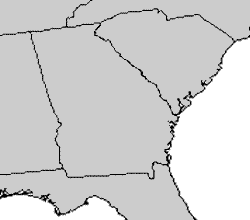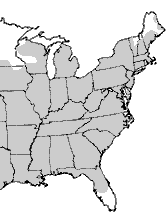Bullfrog (Rana [Lithobates] catesbeiana)
American Bullfrog (Lithobates catesbeiana)



Bullfrog call
Description: The largest frog in North America, reaching 9–20 cm (3.5–8 in) in length. Dorsal coloration ranges from plain green to mottled gray or brown on a green background; individuals in the Southeast may be heavily patterned with dark gray, brown, or black above and thick mottling below. The venter is whitish with gray mottling, and adult males often display a yellow throat. It lacks dorsolateral ridges, distinguishing it from the similar Green Frog (L. clamitans). It differs from the Pig Frog (L. grylio) by its broader snout and shorter toe webbing, which does not extend to the tips.
Range and Habitat: Native to the eastern and central United States, and widespread due to introductions across the West and internationally. Common throughout Georgia and South Carolina, inhabiting nearly any aquatic environment. Breeds in permanent water bodies and is more tolerant of fish than most southeastern amphibians.
Habits: Primarily aquatic but may be found on land at night or during wet weather. Commonly observed along the edges of lakes, ponds, and wetlands in emergent vegetation. A highly opportunistic predator, consuming insects, amphibians, reptiles, small mammals, birds, and even other bullfrogs. Breeding occurs from late spring through summer. Males call sporadically rather than forming large choruses. Females lay 15,000–20,000 eggs per season. Tadpoles are large and may take 1–3 years to complete metamorphosis.
Call: A deep, resonant “jug-o-rum,” characteristic of summer evenings. When seized by predators, bullfrogs emit a loud, piercing screech that may startle or draw attention to the predator.
Conservation Status: Abundant across its native range with no major threats other than wetland loss. Harvested in some areas for food. Where introduced outside its native range, considered an invasive species due to its voracious predation, which has led to declines of native amphibians and reptiles.



